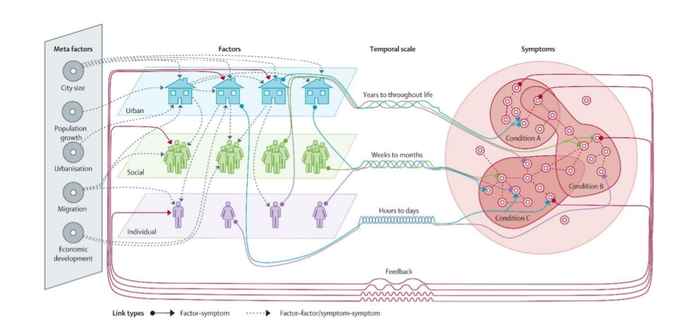2.9 Advancing urban mental health research: from complexity science to actionable targets for intervention
Junus van der Wal, Claudia van Borkulo, Marie Deserno, Josefien Breedvelt, Mike Lees, John Lokman, Denny Borsboom, Damiaan Denys, Ruth van Holst, Marten Smidt, Karien Stronks, Paul Lucassen, Julia van Weert, Peter Sloot, Claudi Bockting and Reinout Wiers
Keywords: Mental health; Urbanicity; Depression; Anxiety; Addiction; Literature review; Complexity; Interventions.
Author Junus van der Wal on the article:
Urbanisation is on the rise across the globe, as are common mental disorders (CMDs; depressive, anxiety, and substance use disorders). In this paper, we discuss how urbanicity and risk of CMDs relate to each other and call for a complexity science approach to advance our understanding of this interrelationship.
First, we performed an ecological analysis using recent data on urbanicity and CMD burden in 191 countries, indicating a positive non-linear relationship, with a higher CMD prevalence in more urbanised countries, most prominently for anxiety disorders. We also performed a review of meta-analytic studies on the association between urban factors and CMD risk. Here, we identified factors relating to the ambient (e.g., air pollution or noise), physical (e.g., built environment), and social (e.g., socioeconomic inequalities or crime) urban environment and revealed differences per diagnosis. While identification of these factors adds to our knowledge on what factors in the urban environment may increase risk of CMDs, it does not provide a comprehensive explanation of how CMDs arise within the urban environment.
Instead, we argue that factors in the urban environment likely operate as a complex system, interacting with each other and with individual city inhabitants (including their psychological and neurobiological characteristics), to shape mental health in an urban context. These interactions exhibit dynamics such as feedback loop mechanisms over various timescales, rendering temporal system behaviour characterised by non-linearity and limited predictability over time. Accordingly, in this paper we present a conceptual framework for future urban mental health research, adopting a complexity science approach (figure 1). Also, we discuss how different complexity science methodologies (e.g., network analyses, system-dynamic modelling, agent-based modelling) could facilitate identification of parts of the system at large that are most instrumental to increase in CMD risk.
This paper is of interest for researchers from all fields that study aspects of mental health and wellbeing of individuals in an urban context, such as psychology, neurobiology, or urban studies. The framework we propose aims to bridge all such disciplines in a quest to develop a more comprehensive understanding of how the urban environment shapes our mental health, using a complexity science approach. Potentially, the framework could be extended to theorize on the interplay between the urban environment and other urban health issue as well, such as obesity, cardiovascular diseases, or healthy development childhood or aging in elderly. The Centre for Urban Mental Health at the University of Amsterdam is dedicated to bringing together input from multiple scientific disciplines, as well as from stakeholders such as health care institutions or the (local) government, and individuals with lived experience. In doing so, our main goal is to identify actionable targets for treatment and policy, aimed at decreasing CMD burden in an urban context.
For more information on the Centre for Urban Mental Health, see: https://www.centreforurbanmentalhealth.com/

[1]: van der Wal, J.M., van Borkulo, C.D., Deserno, M.K., Breedvelt, J.J.F., Lees, M., Lokman, J.C., Borsboom, D., Denys, D., van Holst, R.J., Smidt, M.P., Stronks, K., Lucassen, P.J., van Weert, J.C.M., Sloot, P.M.A., Bockting*, C.L., Wiers*, R.W. (2021). Advancing urban mental health research: from complexity science to actionable targets for intervention. Lancet Psychiatry, published online: October 7th 2021. https://doi.org/10.1016/S2215-0366(21)00047-X
*Co-senior authors
[2]: Reprinted from [1], page 6 (figure 3), Copyright Elsevier B.V. (2021), with permission from Elsevier.